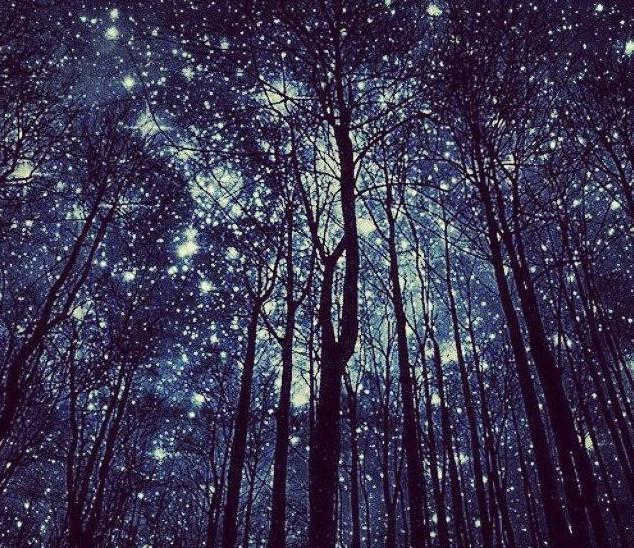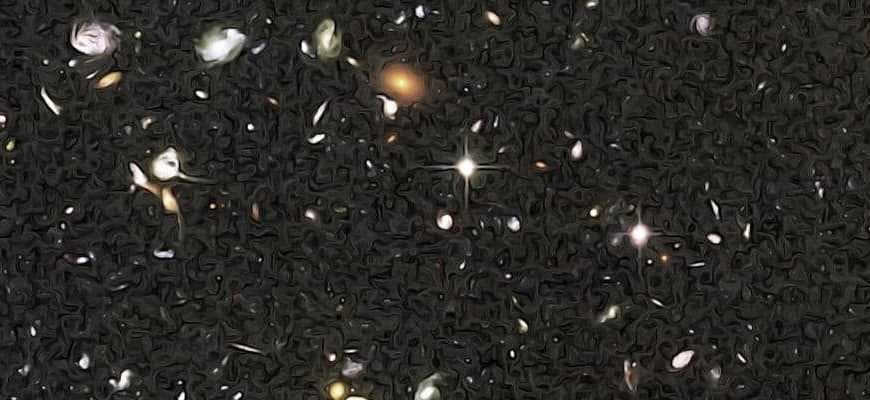
Perhaps you’ve come across the saying: “When you gaze up at the heavens, you’re actually peering into the past. Many of the stars visible in the nighttime sky have long since faded away.” This deep philosophical notion serves as a way for individuals to come to terms with the reality that all things eventually come to an end… However, let’s leave these metaphysical inquiries to the philosophers and delve into the heart of the matter. Is there any validity to this assertion?
Light is an incredibly fast phenomenon. However, stars are also situated at significant distances
Light traverses a vacuum at an astonishing speed of nearly 300,000 kilometers per second. Nevertheless, even the stars that are closest to the Sun reside at considerable distances. Consequently, light emitted from these stars can traverse through the vast expanse of space for several years before finally reaching our solar system. For instance, the star system that is nearest to us, Alpha Centauri, is approximately 4.25 light-years away. Additionally, the most luminous star visible in our sky, Sirius, is situated at a distance of 8.6 light-years. This implies that if a hypothetical scenario were to occur, where a thousand nuclear warheads were detonated on Sirius by an irrational general, we would only become aware of this event 8.6 years later.
Deneb, located in the Swan constellation, is one of the farthest stars visible to the naked eye. It is approximately 3,000 light years away from Earth, which means that the light we see from it began its journey when ancient Rome was just emerging as a powerful empire. At that time, Deneb was not even marked on any maps. While it may seem like a significant amount of time has passed since then, in comparison to the average lifespan of a billion-year-old star, it is merely a fleeting moment. Therefore, unless there has been a significant cosmic event near Deneb, this star remains in its original position.
Some of the stars visible in the sky are actually no longer in existence.
Consider a star named Betelgeuse, for example. It is one of those stars that could potentially explode at any given moment. However, due to its distance of 650 light-years away, if it had exploded 200 years ago, we would not be aware of it until another 450 years.
There are several large galaxies that can still be observed with the naked eye in outer space. One of the most renowned ones is Andromeda, which is approximately two and a half million light years away. It is estimated to contain between four hundred billion and 1 trillion stars. Naturally, some of these stars may have already ceased to exist within the past two and a half million years. However, the majority of them are likely still present, and it is improbable that anything significant has occurred to them.
Now, when you peer through a telescope…
Nonetheless, the scenario takes a dramatic turn if you employ a telescope for your observations. The capability to gaze at enormously vast distances emerges. Billions of light years stretch before you. Considering that a star similar to our Sun endures for approximately 10 billion years, it becomes apparent that numerous stars we perceive in the farthest galaxies have already ceased to exist. However, as peculiar as it may sound, even at these immense distances, we cannot definitively assert that we are witnessing the remnants of countless stars that have already completed their life cycles.
Here is another fascinating aspect. In those distant galaxies, numerous fresh stars have emerged during the time their light has been journeying towards us, which we have not yet been able to observe. Additionally, there exist numerous stars within those galaxies that are undoubtedly still in existence. The explanation for this is that the smallest stars possess significantly longer lifespans compared to the largest stars. Red dwarfs, for example, are believed to endure for anywhere from 200 billion to tens of trillions of years. This is considerably longer than the projected lifespan of the universe itself. Consequently, they have a vast amount of time ahead of them and will remain in their current locations.
The brightness of faraway celestial bodies. Glimpsing into history
Furthermore, it’s important to note that the Sun is never seen in real-time. In case you were not aware, there is an eight-minute delay in observing our star!
Consider the possibility of an incredibly advanced extraterrestrial civilization existing in space. This civilization possesses the technology to observe planets with the same level of detail as our satellites. If there were a hypothetical extraterrestrial scientist located 3000 light years away, they would be able to witness the earliest moments of ancient Rome through their telescope! Just imagine the astonishment they would experience upon discovering the existence of satellites orbiting the planet. Moreover, they would witness the once mighty Roman empire crumble to dust over the passing centuries…
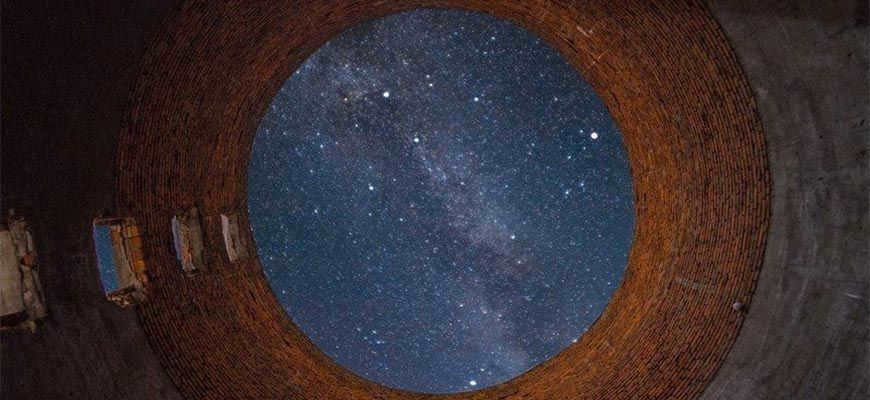
Natural Phenomenon
There exists an ancient and widely held belief that it is possible to observe the presence of stars in the sky while being situated at the bottom of a deep well during daylight hours. This concept has been supported by numerous reputable sources throughout history. Over two thousand years ago, the renowned Greek philosopher Aristotle proclaimed that stars could indeed be visible during the day from the depths of a cave. Subsequently, the Roman scholar Pliny reiterated this notion, replacing the cave with a well.
Multiple authors have referenced this phenomenon in their writings. One such example is Rudyard Kipling, who wrote in his work “the stars can be seen at noon from the bottom of a deep gorge”. Additionally, Robert Ball provides detailed instructions on observing stars during daylight hours in his book “Star-Land” (Boston, 1889). He suggests that by positioning oneself at the bottom of a tall stovepipe, the darkness within enhances a person’s visual acuity, making it possible to see stars even during the day.
The renowned German naturalist and explorer, Alexander Humboldt, embarked on a quest to observe the stars during the daytime by venturing into the depths of Siberian and American mines. Unfortunately, his efforts were in vain. Today, similar inquisitive minds exist. Take, for instance, journalist Leonid Repin from the newspaper “Komsomolskaya Pravda,” who, in the May 24, 1978 issue, wrote:
“There is a belief that even in the midst of daylight, one can witness the stars illuminating the sky if they descend into a profound well. Intrigued by this notion, I decided to put it to the test and descended into a well that stretched sixty meters deep. Alas, I was unable to perceive the stars, only a minute square of resplendent, azure heavens.”
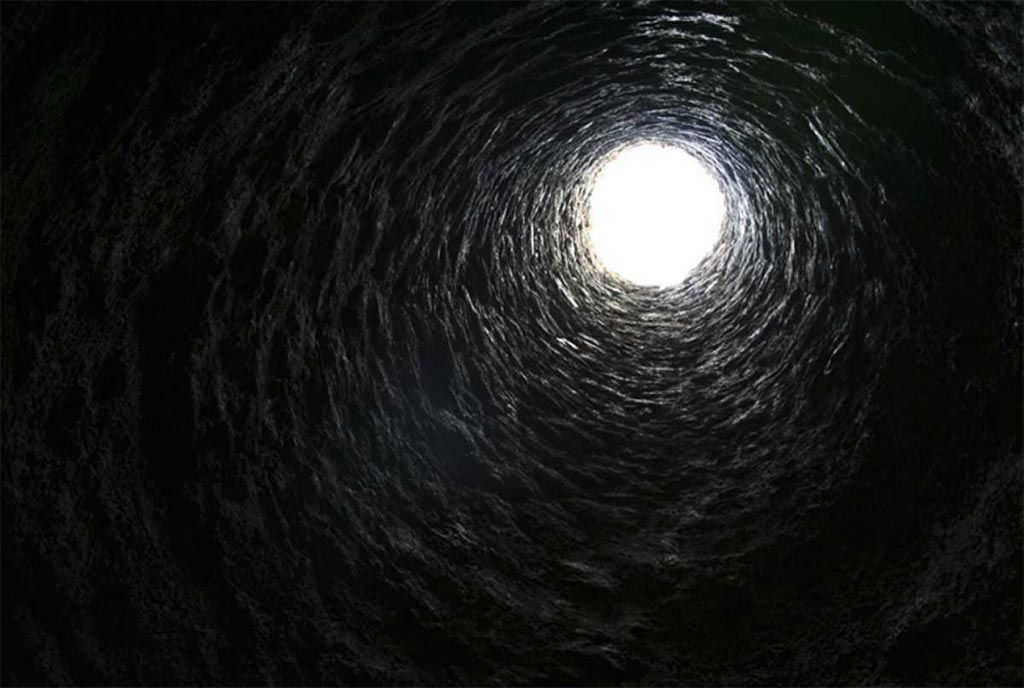
Presenting another account, Richard Sanderson, an experienced amateur astronomer from Springfield, Massachusetts, USA, shares his firsthand observations in the renowned publication Skeptical Inquirer:
About two decades ago, while working as an intern at the planetarium of the Springfield Museum of Science, my colleagues and I engaged in a debate regarding this age-old belief. Our conversation caught the attention of the museum’s director, Frank Korkosch, who proposed an experimental resolution. He led us to the museum’s basement, where a tall and narrow chimney stood. It had a small opening that allowed us to peek inside. I can still recall the thrill of the possibility of witnessing the celestial bodies in broad daylight.
As I looked up along the chimney, I saw a radiant circle of blue sky contrasting against the pitch-black interior of the furnace. The darkness surrounding it caused my pupils to dilate, making the patch of sky appear even more luminous. It immediately dawned on me that this “contraption” would not enable me to see the stars during the day. After we exited the museum’s basement, Director Korkosch mentioned that only one star could be observed during the day under favorable weather conditions: the sun.
According to eyewitnesses, the stars cannot be seen during the day from both the deep well and the tall chimney. Nevertheless, it would be premature to draw conclusions: there are certain chimneys through which it is still possible to observe stars in daylight. This phenomenon occurs specifically with astronomical tubes, or telescopes.
Why can’t we see stars during the daytime?
What is the explanation? Why is it possible to see stars in the daytime with a “telescope with lenses” but not with a regular telescope?
First and foremost, let’s explore why stars are not visible during the day. The answer is quite clear: it is because the sky is bright due to sunlight being scattered by the atmosphere. However, if this background brightness diminishes for any reason, such as during a total solar eclipse, the bright stars and planets can be seen perfectly during the day.

The stars are easily visible in open space or from the surface of the Moon, where the sky appears completely black and free of any light background. However, on Earth, the scattered sunlight in the atmosphere obscures our view of the stars. It is interesting to note that the stars’ own light is not affected or weakened during this process.
How we perceive
In order to grasp the concept, we must envision how our vision works. As you are aware, the primary lens, known as the pupil, forms an image on the rear surface of the eye, which is covered by a light-sensitive layer called the retina. The retina is comprised of numerous elementary light receptors, known as cones and rods. Although they have varying degrees of light sensitivity, we will refer to all of them as cones for simplicity. What matters is that each cone relays information to the brain regarding the light that falls upon it, and the brain then synthesizes these individual messages (signals) to form a complete visual representation.
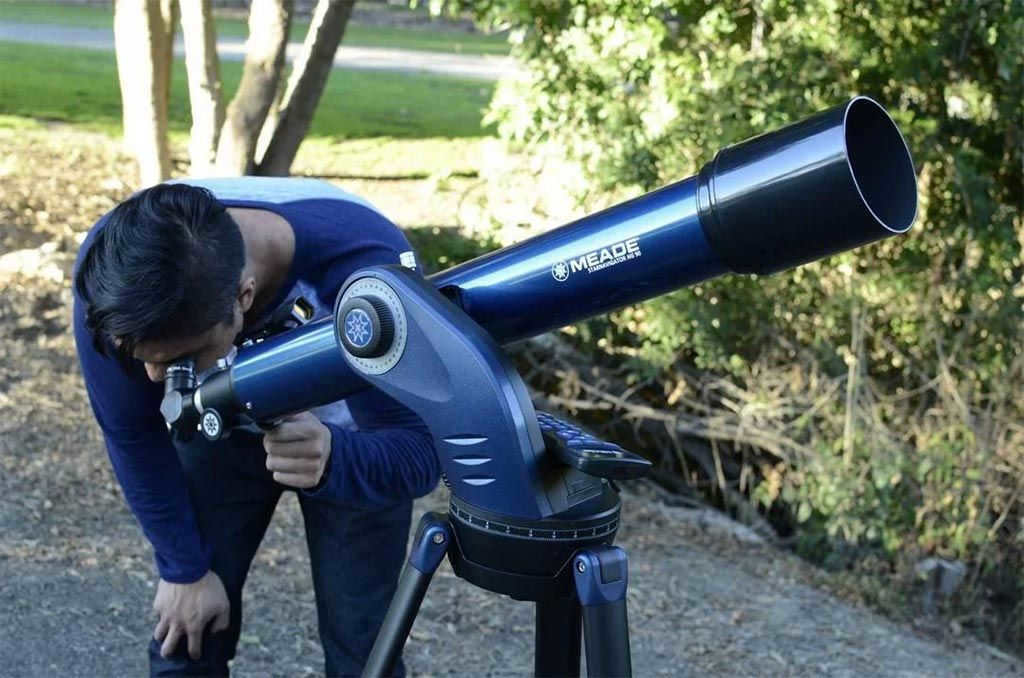
In this scenario, the telescope enhances the eye’s resolution by enlarging the angular size of the objects being observed. Simultaneously, the portion of the sky that would normally be projected onto one cone with naked eye observations is now projected onto multiple cones through the telescope. As a result, each cone receives a proportionally reduced amount of light (for instance, if the telescope increases the angular diameter of objects by A times, the observed brightness of the sky decreases by A*2 times). However, stars possess an incredibly small angular size, so their light still falls onto a single cone. Consequently, the star’s light effectively appears “solid” in contrast to the diminished brightness of the surrounding sky, making it visible.
What is the conclusion? Is it possible to observe the faintest stars during the day by purchasing a telescope with a high level of magnification? No, it is not that simple.
The Earth’s atmosphere is not uniform, which means that the image of a star becomes distorted and appears with a specific angular size, even if it is very small. On a clear night, at high altitudes in the mountains, this angular size is approximately 1 arc second. However, during the daytime, at sea level, the angular size is not less than 2-3 arc seconds.
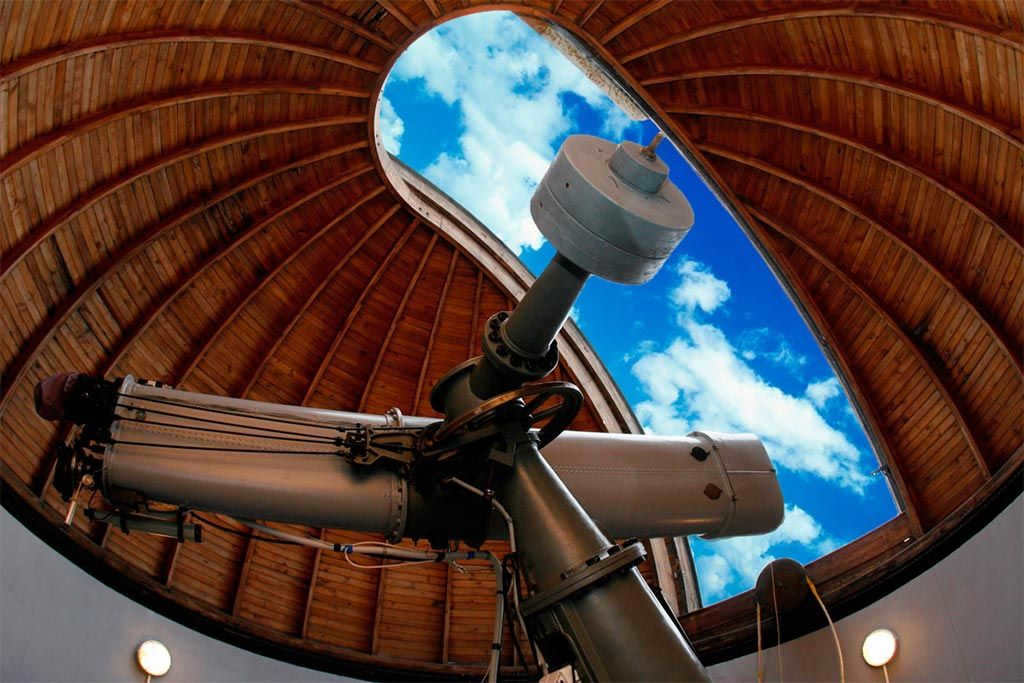
Therefore, the maximum level of magnification that can be employed will be determined in order to maintain the star as a singular point of focus. This level typically falls within the range of 30-60 magnifications. There is no benefit to utilizing a higher level of magnification, as the image of the star will be dispersed across multiple cones simultaneously, resulting in a weakened appearance akin to the brightness of the sky.
Let’s now assess the ability of a telescope to render faint stars visible during daylight hours.
Under optimal conditions, the brightness of the daytime sky measures around -5m per square minute of arc, roughly equivalent to a single cone. By comparison, Venus possesses a brightness of approximately -4m. Hence, we can surmise that a star will become discernible if its luminosity is no more than one magnitude lower than the surface brightness of the sky per square minute.
By utilizing a telescope equipped with a magnification factor of 45x, we are able to achieve a significant decrease in the luminosity of the celestial background when compared to the luminosity of the star itself, resulting in a reduction of approximately 452 (equivalent to about 2000 times), which is equivalent to about 8m. Consequently, within the telescope’s field of view, the brightness of the sky will be reduced to a level of +3m per square minute, granting us the ability to observe stars with a magnitude of up to +4m. Empirical evidence gathered from astronomical observations strongly supports this assertion.
Can stars be observed from a well?
Now that we have discussed telescopes, let’s turn our attention back to wells. Is it possible for a well to diminish the brightness of the sky enough for an observer inside to see the stars? In theory, from a purely geometric standpoint, this is possible. By covering the entire field of vision except for a small area, the amount of light reaching the observer from that area would be comparable to the light emitted by a star.
An observer at the bottom of a well would be able to see the opening at an angle of less than one minute. For a well with a diameter of 1 meter, its depth would need to be greater than 1/sin1’=3.4 km!
In this scenario, the observer will only be able to see the well’s opening as a single point of brightness, which will momentarily increase in intensity if a star happens to pass directly overhead. Despite any desire to do so, it is challenging to classify this activity as “stargazing.”
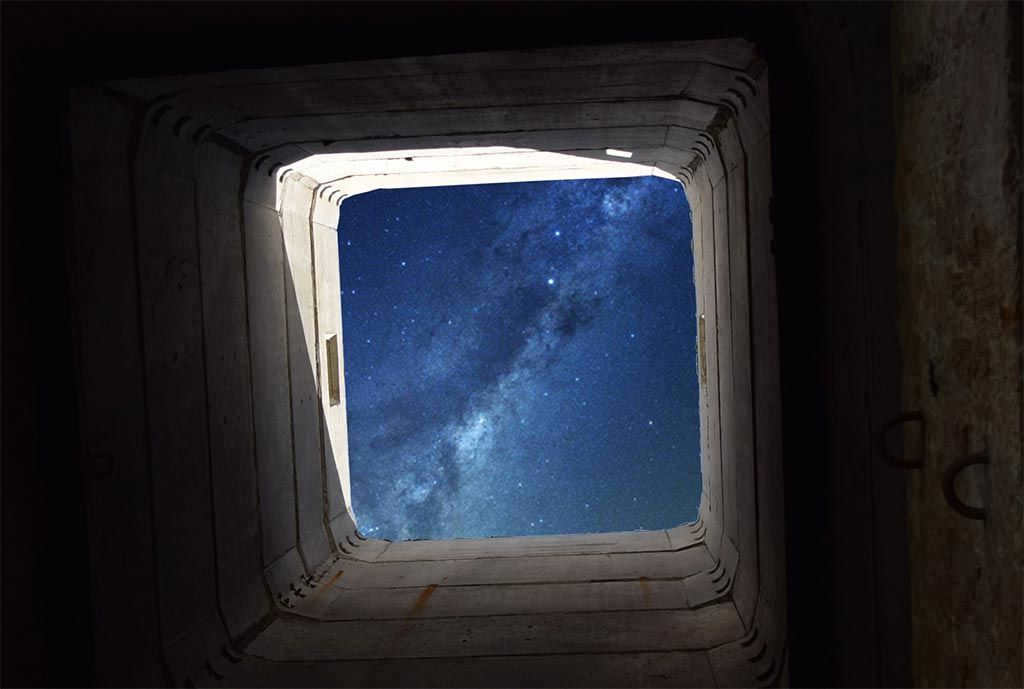
The tall cylinder can also serve as a tool for observing stars during the day. In fact, it forms a pathway through which there is minimal dispersion of sunlight. Furthermore, if this cylinder extends through the entirety of the atmosphere, we would be able to view the stars at any given time! Nevertheless, it is important to consider that the majority of the Earth’s atmosphere is concentrated within the outermost 20 kilometers. Thus, the tube would need to be quite lengthy!
Thus, the myth of observing the stars in the daytime from a deep well or a tall pipe has been debunked. However, its origins remain a mystery. We can only speculate on its source. It is possible that someone, while at the bottom of a well or a mine, actually witnessed Venus crossing the sky. However, this scenario is highly unlikely and would only be possible in tropical countries where Venus is visible at the zenith. A more plausible explanation is that individuals, while descending into a well or a deep cave, noticed dust particles illuminated by the Sun against the dark walls. These particles may have been mistaken for stars.
There is a common curiosity among people about why the stars are not visible in the daytime sky. Despite their constant presence, the human eye is incapable of perceiving them due to the overwhelming brightness of the sun. Scientists have provided explanations for this phenomenon, yet many individuals still struggle to grasp the underlying reasons.
Every star is a massive ball of gas that emits its own light. This sets them apart from planets and satellites, which rely on reflecting sunlight off their surfaces. Stars have their own radiance because they have nothing to reflect the sun’s rays.
This is why stars are not visible during the day. There are also other factors to consider:
The atmosphere is composed of numerous elements, including carbon dioxide, hydrogen, and various other gases (including water molecules), which are invisible to the naked eye.
When sunlight passes through the atmosphere, it takes on a specific color based on its wavelength:
- Short wavelengths, such as blue, violet, and cyan, create a blue sky.
- Long wavelengths, like red during sunset.
The Sun, being a star, possesses such intense brightness that it surpasses the radiance of any other stars and celestial bodies, including planets. The feeble luminosity of all other entities in the universe pales in comparison to the Sun’s glorious light.

Consequently, stars are not visible during daylight hours, even if you change your location on the planet (due to the scattering of sunlight in the atmosphere). The presence of these specific elements in the air also plays a significant role:
Microscopic dust does not retain the blue hue from the sun.
The existence of molecules from certain gases (such as red phosphorus) also impacts the color spectrum.
However, during daylight hours, only the most brilliant star of all – the Sun – is visible to the naked eye.
Why are other stars not visible behind the Sun?
The reason is quite simple: the Sun is the solitary star within our own solar system. All of the other stars exist much further away, beyond its reach. Consequently, these stars are not visible during the daytime because they are too distant, and their radiance is scattered and obstructed by the Sun’s rays.
In addition, the Sun possesses distinctive layers that differentiate it from the rest of the stars we have studied. While it is composed of gases, it also harbors a constantly moving atmosphere that expands to three or four times the size of the Sun itself. This outer atmosphere represents merely the initial layer among many others that form the Sun.
Considering all of this, it is once again reaffirmed that stars cannot be observed during the daytime due to the presence of this “giant” object, which emits such a strong luminosity as a result of its composition that nothing can obstruct it.
Simultaneously, the structure of the human eye also plays a role:
- During the nighttime, under the open sky, one can observe the stars for hours on end;
- However, even a mere 3 seconds of direct gazing at the sun is enough to significantly harm one’s vision, and 6 seconds would necessitate surgical intervention to restore the structure of the eye.
Therefore, it is once again reaffirmed that the Sun is considerably brighter than other stars. Additionally, it becomes evident that humans are unable to use their eyes to focus on objects that are further away, rather than the Sun’s rays.

Despite the fact that even this will not suffice, as a result of the refraction and dispersion of light, the remaining stars blend seamlessly with the expanse of the sky, the sun’s rays, and the molecules of various substances. Even advanced technology will prove futile in allowing us to observe the stars during daylight hours, let alone relying on the naked eye.
How to observe stars during the day?
The possibility to observe stars during the daytime has been a topic of discussion among ancient scholars such as Aristotle and Pliny. According to their writings, it was believed that stars could be seen in the daytime from a deep well, a cave, or even through a long stovepipe. This viewpoint has generated differing opinions, with some considering it to be true while others dismiss it as universal nonsense.
A more recent account comes from Robert Ball in 1889, who claimed to have observed several stars in the daytime sky while inside a long stovepipe. He argued that in a dark and narrow chimney, one’s vision becomes significantly clearer.
This concept holds some merit: when transitioning from a brightly lit environment to a dark room, it initially becomes impossible to see anything. However, as the eyes adjust to the darkness, objects in the room gradually become distinguishable.
Unfortunately, there is no concrete evidence to support this theory. However, many individuals have eagerly worked to debunk it. Here are some notable figures who have attempted to disprove the theory:
- Alexander Humbolt, during various periods of his life, ventured into the deepest mines in both America and Siberia. Despite his efforts, he was unable to locate any stars.
- Leonid Repin, a journalist from “Komsomolskaya Pravda,” descended to the bottom of a 60-meter well in 1978. Upon looking up, he only observed a small portion of the daytime sky, devoid of any stars.
Is it possible to observe stars during the daytime? The answer is yes, although replicating such an occurrence in a controlled laboratory environment is impossible. This unique phenomenon can only be experienced during a solar eclipse.
During a solar eclipse, the moon positions itself between the sun and the observer, resulting in a temporary darkness during the daytime. As a result, the absence of sunlight prevents the refraction and scattering of starlight, allowing stars to become visible during the day.
Can you see stars during the day (video)?
In this video, you will discover if it is possible to observe stars in the daytime, explore the structure and functionality of the human eye in relation to perceiving light, and understand the reasons behind why only the Sun is visible in the sky during daylight hours.
Surprisingly, it is technically feasible to observe the stars during daylight. However, due to the laws of physics and the structure of the human eye, it is impossible to do so through conventional means. The scattering and refraction of light from distant celestial bodies prevent us from perceiving them, even with the aid of a telescope. This is particularly challenging when the intense radiation from the Sun interferes with our observations.
These celestial wonders, the stars, are truly captivating. It’s a delight to gaze at them, to marvel at the night sky, and to dream and make wishes. However, during the daytime, the sky takes on a different character. It is filled with brightness from the Sun, sometimes even causing discomfort to our eyes. Where do the stars disappear to? It seems as if they dissolve into the morning light. What exactly happens to them during the day?
The Essence of Universal Light
Stars, these remarkably captivating and enigmatic cosmic entities, remain visible at all times, be it day or night. Although they undergo a life cycle from birth to eventual extinction, they persistently shine throughout their existence. However, during daylight hours, the intense radiance of the Sun overwhelms their luminosity. The Sun’s brilliance is so overpowering that it leaves no chance for other sources of light to be seen. Yet, when Earth rotates to face away from the Sun, the nocturnal sky reveals itself to us. On clear nights, we are able to witness the celestial luminaries shimmering like precious gemstones. Hence, the stars remain hidden from our view during the day, but once the Sun disappears below the horizon, they illuminate the vastness of outer space in all their resplendent glory.
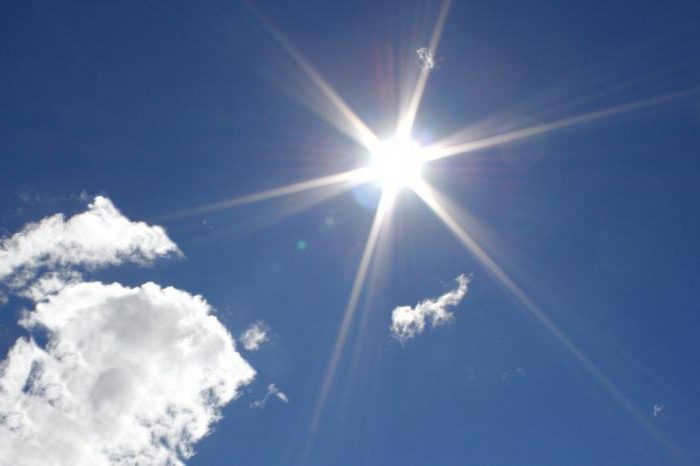
Unique Experience
Here’s an interesting experiment that demonstrates the reason behind why stars are not visible during the day, and vice versa when it’s dark. To perform this experiment, create small holes in a cardboard box and place a flashlight inside (you can also use a table lamp or any other light source). In a dark room with all other lights turned off, the holes in the cardboard will light up and resemble tiny stars. However, if you switch on the main light in the room, the glow from the cardboard holes will disappear. This simple yet effective experiment helps us understand why stars are not visible during the day, but become visible to us once darkness falls and they shine in the sky.

Legends and Reality
Space objects have always been surrounded by various myths and legends. One popular belief suggests that it is possible to see stars during the daytime by being in a well, a mine, or even a stovepipe. While stars in the sky remain static, planets are constantly moving and can be found in different positions in the universe.
For centuries, the legend of wells, mines, and wide stovepipes was widely accepted as true. This notion was supported by ancient Greek philosopher Aristotle (4th century BC) and English physicist-astronomer John Herschel (19th century).
Contrary to popular belief, it is not possible to see stars in the sky during the day even if you are at the bottom of a well. This long-standing myth has no scientific basis and it is unclear why it has persisted for so long.
This misconception likely originated from an experiment conducted by Leonardo da Vinci. In order to observe the stars from Earth, he created a small hole in a sheet of paper and looked through it, placing it in front of his eyes. What he saw were tiny dots of light without any rays or flickering. This is because the starburst effect is actually an optical illusion caused by the structure of our eyes. Our eyes have a lens with a fibrous structure that refracts light. When you look at stars through a small aperture, only a narrow beam of light passes through the lens, without being distorted.
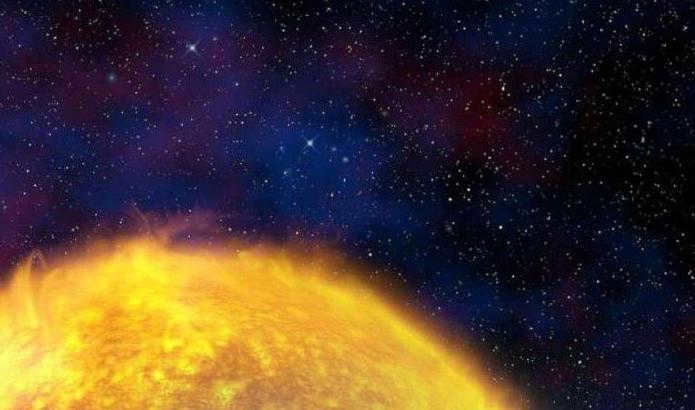

The evolution of the hypothesis
Inquisitive minds have long pondered the question, “Is it possible to see stars in the daytime from a well?” Inspired by Aristotle’s deep cave theory, the Roman scientist Pliny was among the first to explore this phenomenon. His inquiry sparked the interest of many writers and thinkers throughout history, including Kipling and R. Ball. Over time, various individuals, such as the German naturalist and traveler Alexander Humboldt and the astronomer R. Sanderson from Springfield, conducted their own experiments in an attempt to observe the celestial luminaries during daylight hours. However, these endeavors yielded inconclusive results.
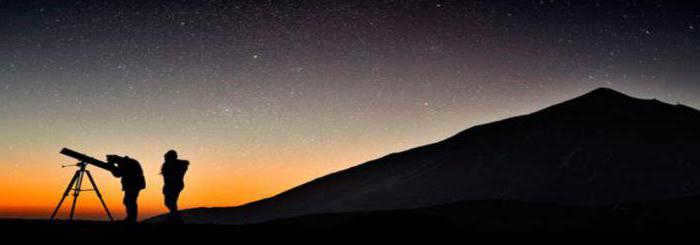
It appears that only a bright spot of blue sky is visible from such deep caves, wells, and chimneys, provided that the weather is clear. During the day, only the sun is visible among the celestial lights. The Earth and the stars are closely intertwined. However, the intense brilliance of the nearest star blinds us to the point that the others fade into the background. It is only when a portion of the planet is engulfed in darkness that the beauty of distant and captivating stars becomes visible to us. Of course, humanity’s insatiable curiosity about the unknown has led to the creation of astronomical telescopes, which now allow us to observe the stars even in broad daylight.
Origin
The origin of a star, as well as its demise, can be observed in the night sky. Astronomers have been studying these phenomena for a long time and have made numerous breakthroughs. All of these discoveries are documented in specialized scientific literature. Stars are luminous spheres of immense size. However, what causes them to emit light, flicker, and display various colors?
These celestial entities are formed from a diffuse mixture of gas and dust, which undergoes gravitational compression in denser regions, aided by the influence of their own gravity. The interstellar medium consists primarily of gas (hydrogen and helium) along with solid mineral particles in the form of dust. Our primary celestial body is a star known as the Sun. Without it, life as we know it would be impossible. Interestingly, many stars are much larger than the Sun. Yet, we do not feel their gravitational pull and can continue to exist in tranquility without their presence.
Our planet relies on the Sun for both heat and light, as it is situated in close proximity to us. Therefore, it is crucial for us to experience its warmth and brightness. While stars are hotter and larger than the Sun, they are located at much greater distances from us, making it possible for us to only observe their light at night.
During the night, stars can be seen as small twinkling dots in the sky. However, they are not visible during the day. This is because starlight is similar to the rays emitted by a flashlight, which are difficult to perceive in daylight. Nonetheless, at night, starlight becomes indispensable as it effectively illuminates our path.
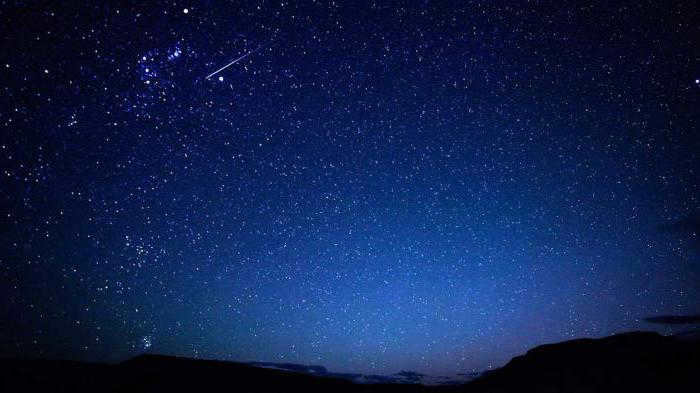
When are the stars in the night sky the most radiant and what causes their luminosity?
The month of August presents optimal conditions for observing the stars. During this time, the nights are enveloped in darkness and the atmosphere is exceptionally clear. It almost feels as if one can touch the heavens. Children, gazing up at the sky, often ponder, “Why do the stars emit light and where do they go when they fall?” In August, stargazing is commonly practiced, offering a mesmerizing spectacle that captivates our eyes and souls. There exists a belief that when one spots a shooting star, they should make a wish, as it is sure to be granted.
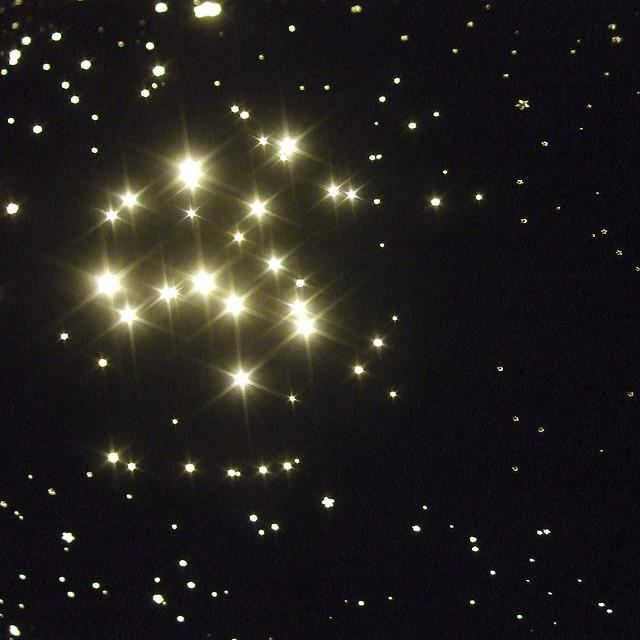
What is the appearance of light?
Stars, which are cosmic objects, emit an immense amount of thermal energy, accompanied by a powerful emission of light. A portion of this light reaches our planet, allowing us to observe it. This is the simple answer to the question: “Why do stars illuminate the sky, and do all celestial bodies belong to them?” For instance, the Moon is Earth’s satellite, and Venus is a planet within our solar system. We do not perceive their own light but only the light they reflect. Stars, on the other hand, are the actual source of light radiation as a result of energy release.
Various celestial bodies emit different colors of light, some appearing white, while others display shades of blue or orange. In addition, certain objects sparkle with a range of vibrant hues. The question arises: what causes this phenomenon, and why do stars radiate in various colors? The answer lies in their colossal gas-filled formations, subjected to extremely high temperatures. Consequently, as these temperatures vary, stars emanate differing levels of luminescence: the most scorching ones emit blue light, followed by white, then the relatively cooler yellow, orange, and finally red.
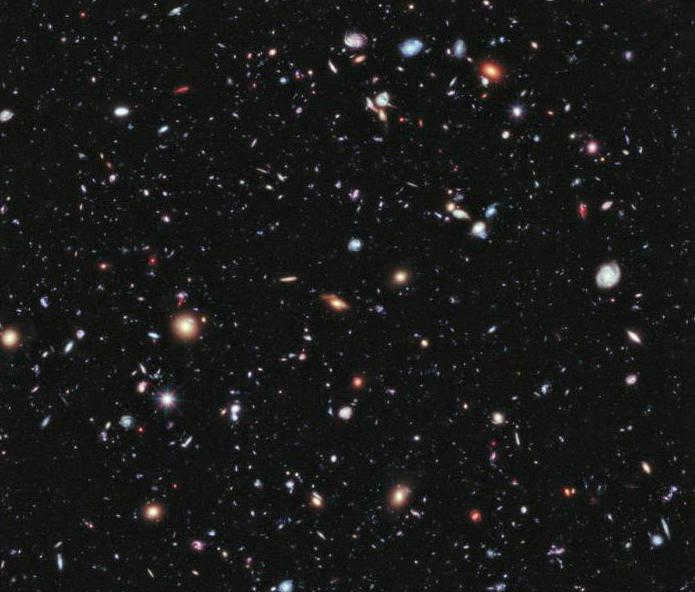
The Phenomenon of Twinkling
Many individuals often ponder why stars emit light at night and why their light appears to flicker. However, stars do not actually twinkle; this is merely an illusion. The reality is that starlight must traverse the Earth’s atmosphere. During this journey, the light beam undergoes numerous refractions and alterations due to the vast distances it travels. To our eyes, these alterations manifest as flickering.
